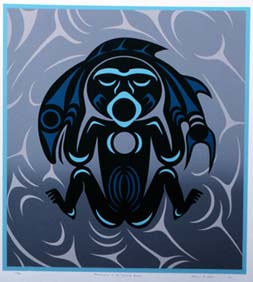
Reflection of the Sockeye People
© Copyright Susan A. Point 1990. All Rights Reserved.

Reflection of the Sockeye People
© Copyright Susan A. Point 1990.
All Rights Reserved.
Historically, the first use of
silk screening by a Northwest Coast
native artist occurred in 1949. Ellen Neel, a Kwakwaka'wakw artist, had her designs screened
onto cloth scarves that rapidly became commercially successful. (Blackman et al. 1981:50).
Soon thereafter, a non-native named Charles Greul began to market his silk screen designs
on rice paper. His designs, while inaccurate representations of Northwest Coast
designs, sold well on the tourist market. It was in part in reaction to Gruel's works
that some native artists decided to begin producing silk screened works of their own, hoping
to create a better understanding and appreciation of traditional Northwest Coast design
(Blackman et al. 1981:50). Henry Speck, a Kwakwaka'wakw artist, had several of his painted
designs reproduced in print form in the early 1960s. Around the same time, two
Kwakwaka'wakw artists, Tony Hunt and Doug Cranmer, began producing silk screen designs of
their own. In 1965, Tsimshian artist Roy Vickers, a high school student at the time,
produced his first set of prints. Three years later a well-known Haida artist, Robert Davidson,
joined the others in producing serigraphs
of his own (Blackman et al. 1981: 50).
They too would rapidly gain recognition for their prints in addition to their other
artistic productions, and along with Hunt they would make serigraphy a consistent part
of their artistic production. In the 1970s, the Kitanmax School of Northwest Coast
Indian Art at 'Ksan incorporated serigraphy into its art program, and has subsequently
become known for the development of its distinctive graphic style, described as "clean
lined and crisp" with elongated, vibrant formlines that convey a sense of motion
(Stewart 1979:100). By 1977, printmaking was so popular among Northwest Coast artists
that a group of them formed the Northwest Coast Indian Artists Guild in order to achieve
greater recognition for their graphic productions (Blackman et al. 1981:50). Thus, the
media of printmaking caught on with Northwest Coast native artists, and over the years it
has only grown in its popularity with both artists and the public. Since the 1960s,
Northwest Coast prints have provided artists with a new way of communicating cultural
histories, they have been used as potlatch
gifts, thus gaining a cultural status within Native communities, and their sale has
secured for many both artistic recognition and a steady income.
Artists turn to a variety of sources for their inspiration when creating serigraphs.
Crest figures from the northern cultures,
traditionally represented in three-dimensional
carvings such as totem poles and dance regalia, soon found their way onto two-dimensional
prints. Oral traditions and stories were re-told visually in the new media. Museum
collections were studied for their rich caches of historic objects and photographs,
which could be copied and reinterpreted by print artists. A renewed interest in Northwest
Coast art, that arose in the second half of the twentieth century, fueled artists'
investigations of their cultural pasts. However, serigraphy is a modern media, and
as such provides artists with the chance to experiment with representational styles
and content. Native artists explore personal experiences, political statements, and
even Western religious themes in their prints. As succinctly stated by
Margaret Blackman
and Edwin Hall, two collectors of Northwest Coast prints, "Artists have realized that
silk screens are ideal both for producing traditional Northwest Coast Indian designs and
for creating contemporary designs drawing upon traditional motifs and styles. The public
has responded to the increasing availability of prints by becoming more interested in, and
more knowledgeable about, Northwest Coast Indian design" (Blackman et al. 1980:50).
Affordably priced and widely available, serigraphs have become an attractive option for
people interested in collecting Northwest Coast art. As in any market, the consumer's
tastes and preferences have had an effect on the production of the art form. However,
several Northwest Coast artists have continued to challenge their patrons by presenting
them with constantly evolving styles and ever changing representations of diverse themes
and images. Rather than becoming a stagnant form of "tourist art", Northwest Coast prints
have become a vibrant form of artistic expression and exploration, one that interacts with
its audience rather than panders to it.
| BACK | NEXT |
